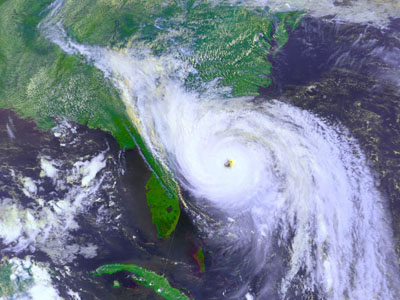The 1989 hurricane season had a total of 11 named tropical cyclones of which 7 attained hurricane strength. Hurricane Hugo, a Category 4 hurricane at landfall, was a classic Cape Verde-type hurricane that devastated the Virgin Islands, Puerto Rico, and South and North Carolina. Developing from a cluster of thunderstorms off the coast of Africa on September 9, 1989, Hugo steadily intensified into a tropical depression (southeast of the Cape Verde Islands) on 10 September, and then a tropical storm on 11 September. On 13 September, the storm became a hurricane. On 15 September, Hugo developed into a Category 5 hurricane, packing 224 km/h (140mph) winds as it approached Guadeloupe and Dominica in the Caribbean. Hugo would go on to destroy 100% of Guadeloupe’s banana crops as well as 60% of the city’s sugarcane crops while leaving 35,000 homeless after destroying 10,000 homes. Early on 18 September, the eye of the hurricane crossed the southwestern coastline of St. Croix, where approximately 90% of the buildings on the island were destroyed by the hurricane’s strong winds. Hugo’s center crossed the eastern end of Puerto Rico early on 19 September and then its track curved slightly to the northwest as a low-pressure system over Georgia changed the steering flow in the atmosphere.
Hurricane Hugo strengthened in the last 12 hours before landfall, where it struck just north of Charleston, South Carolina, early on 22 September as a Category 4 hurricane. High winds associated with Hugo extended far inland, as Charlotte, North Carolina (~320 kilometers [200 miles] inland) reported 110 km/h (69 mph) sustained winds and gusts to 158 km/h (99 mph). By mid-day, Hugo weakened to a tropical storm and continued to move northward across western Virginia and eastern Ohio. By 23 September, Hugo became extratropical over southeastern Canada. In just 24 hours after landfall, Hurricane Hugo had moved out of the United States, less than 960 kilometers (600 miles) from where it first hit. The South Carolina coast, from Charleston to Myrtle Beach, flooded after a large storm surge overwashed the area. Maximum storm tides of 6.1 meters (20 feet) were observed in the Cape Romain-Bulls Bay area. According to the National Weather Service (NWS), this is among the highest storm tides ever recorded along the U.S. East Coast. In total, Hugo was responsible for 50 fatalities, including 21 in the United States, 5 in Puerto Rico, and 24 elsewhere in the Caribbean. At the time, Hugo was considered the most expensive storm to have made U.S. landfall, as over $10 billion ($17.5 billion 2010 USD) in damages were estimated ($7 billion in the mainland U.S alone) Since then five hurricanes have surpassed Hugo in damage including Hurricane Andrew ($26.5 billion 1992 USD), Hurricane Ivan ($18 billion 2004 USD), Hurricane Charley ($16.3 billion 2004), Hurricane Wilma ($29.1 billion 2005 USD), and Hurricane Katrina ($81 billion 2005). Fast facts:
Sources: Case, B. and Mayfield, M. 1990. Annual Summary: Atlantic Hurricane Season of 1989. Monthly Weather Review. 118: 1165- 1177. http://www.aoml.noaa.gov/general/lib/lib1/nhclib/mwreviews/1989.pdf NOAA’s National Hurricane Center, Hurricane Hugo Storm Summary (link to scanned images) Hurricane Hugo Summary, NHC Hurricane Preparedness page: NOAA’s Hydrometerological Prediction Center: Hurricane Hugo Storm Summary Impacts of Hurricane Hugo : September 10-22, 1989 / edited by Charles W. Finkl, Orrin H. Pilkey: PELL GB450 J681 no. 8 Hurricanes, Michael Allaby: 2003 National Weather Service (NWS) Hurricane Hugo, 20th Anniversary NOAA/NWS Natural Disaster Survey Report: Hurricane Hugo Hurricane Hugo “Hurricane Hugo: Damage to a Tropical Rain Forest in Puerto Rico” “Economic Considerations for Post-Hurricane Timber Management” Hurricane Hugo: 20th Anniversary. NOAA. |


